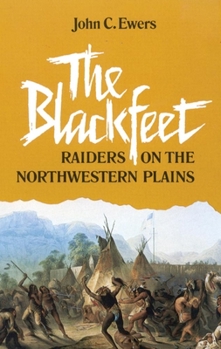The Blackfeet, Volume 49: Raiders on the Northwestern Plains
Select Format
Select Condition 
Book Overview
The Blackfeet were the strongest military power on the northwestern plains throughout the eighteenth century. But the near extinction of buffalo in the late nineteenth century brought dire poverty to the tribe, forcing them to rely in part on the U.S. government for sustenance. In this history of the Blackfeet, historian John C. Ewers relied on his own experience living among the Blackfeet as well as archival research to tell of not only the events...
Format:Paperback
Language:English
ISBN:0806118369
ISBN13:9780806118369
Release Date:September 1983
Publisher:University of Oklahoma Press
Length:362 Pages
Weight:1.05 lbs.
Dimensions:0.8" x 5.8" x 8.0"
Customer Reviews
2 ratings
A good, reasonably thorough, traditional ethnography
Published by Thriftbooks.com User , 18 years ago
This is a good, old-style ethnography of the Blackfoot. It provides a reasonably thorough account of material culture. It's weaker on traditional human culture, especially religious beliefs, but it does a decent job on the outward manifestations of interior beliefs. As you would expect from this kind of ethnography, the book is descriptive, not explanatory. With very few exceptions, it also fails to make any comparisons with other cultures, and any comparisons concern only the tribe's near neighbors such as the Crow or Flatheads. Because he did his work in the 1940s and 1950s, Ewers' respondents include elderly members of the tribe who recall customs of their pre-reservation youth. Along with the accounts of white explorers and traders, these provide Ewers' main sources for the history of the Blackfoot. The parts that stick with me the most are the participants' views of horse raiding expeditions, and the views of "medicine" rituals and objects. Both of these are easily distorted by outsiders, and Ewers seems to get them right. It's interesting to see the tension in this older ethnographic perspective. He's sympathetic to the tribe, he recognizes the inhumanity inflicted on them, and yet he also praises "good" Indian agents who try to help the Blackfoot learn to farm and ranch. He even has some good things to say about Indian boarding schools! Simplifying a bit, Ewers tends to see the political and economic injustices inflicted on the Blackfoot but he cannot see the cultural injustices. The tension is evident even in the title, which refers to the "Blackfeet," even though he notes in the text that this plural is not used n the Blackfoot language and many Blackfoot insist on the singular usage that I have used in this review. Some are even offended by the term. It's not clear that Ewars would understand why this matters.
thoroughly documented research
Published by Thriftbooks.com User , 22 years ago
This book is a researcher's dream, and a pleasure to read. First published in 1958, this volume traces the history of the Blackfeet from pre-horse days through to the 1950's. The author displays a thorough understanding of his subject, and extensively annotates his work, paying meticulous attention to dates, places and names. John C Ewers was the first curator of the Museum of the Plains Indian near Browning, Montana, and many of the items in the museum collection were given to him at the time by elder members of the tribe at the time. He used primary sources for much of his information for this book, and corroborated details with these tribal elders as much as possible. This is a well-written, respectful history of the Blackfeet nation, and ought to remain in print for decades to come. Potential buyers should scan the Table of Contents page for an overview of subjects covered.






